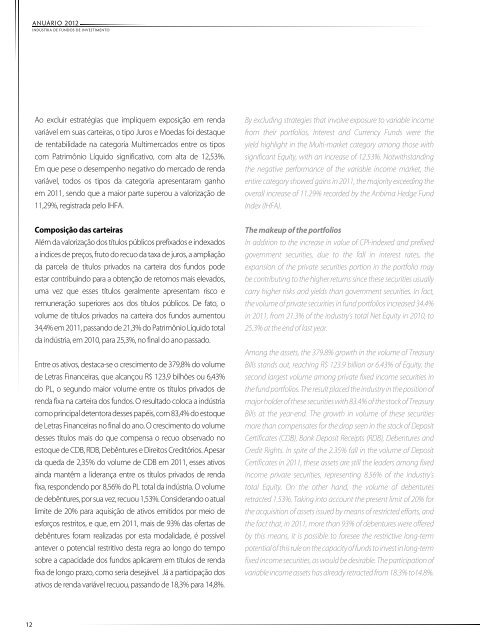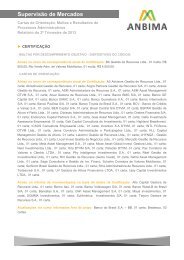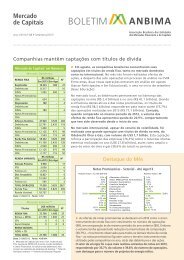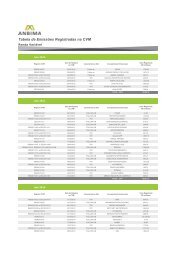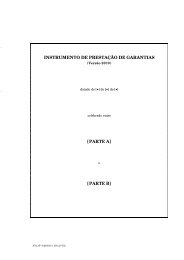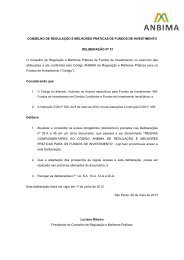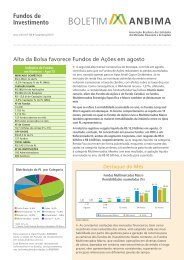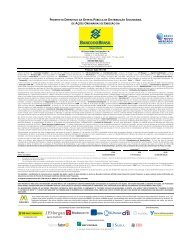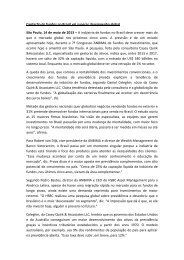The Brazilian Mutual Fund Industry - Anbima
The Brazilian Mutual Fund Industry - Anbima
The Brazilian Mutual Fund Industry - Anbima
Create successful ePaper yourself
Turn your PDF publications into a flip-book with our unique Google optimized e-Paper software.
Anuário 2012Anuário 2012indÚstria de fundos de investimentoindÚstria de fundos de investimentoAo excluir estratégias que impliquem exposição em rendavariável em suas carteiras, o tipo Juros e Moedas foi destaquede rentabilidade na categoria Multimercados entre os tiposcom Patrimônio Líquido significativo, com alta de 12,53%.Em que pese o desempenho negativo do mercado de rendavariável, todos os tipos da categoria apresentaram ganhoem 2011, sendo que a maior parte superou a valorização de11,29%, registrada pelo IHFA.Composição das carteirasAlém da valorização dos títulos públicos prefixados e indexadosa índices de preços, fruto do recuo da taxa de juros, a ampliaçãoda parcela de títulos privados na carteira dos fundos podeestar contribuindo para a obtenção de retornos mais elevados,uma vez que esses títulos geralmente apresentam risco eremuneração superiores aos dos títulos públicos. De fato, ovolume de títulos privados na carteira dos fundos aumentou34,4% em 2011, passando de 21,3% do Patrimônio Líquido totalda indústria, em 2010, para 25,3%, no final do ano passado.Entre os ativos, destaca-se o crescimento de 379,8% do volumede Letras Financeiras, que alcançou R$ 123,9 bilhões ou 6,43%do PL, o segundo maior volume entre os títulos privados derenda fixa na carteira dos fundos. O resultado coloca a indústriacomo principal detentora desses papéis, com 83,4% do estoquede Letras Financeiras no final do ano. O crescimento do volumedesses títulos mais do que compensa o recuo observado noestoque de CDB, RDB, Debêntures e Direitos Creditórios. Apesarda queda de 2,35% do volume de CDB em 2011, esses ativosainda mantêm a liderança entre os títulos privados de rendafixa, respondendo por 8,56% do PL total da indústria. O volumede debêntures, por sua vez, recuou 1,53%. Considerando o atuallimite de 20% para aquisição de ativos emitidos por meio deesforços restritos, e que, em 2011, mais de 93% das ofertas dedebêntures foram realizadas por esta modalidade, é possívelantever o potencial restritivo desta regra ao longo do temposobre a capacidade dos fundos aplicarem em títulos de rendafixa de longo prazo, como seria desejável. Já a participação dosativos de renda variável recuou, passando de 18,3% para 14,8%.By excluding strategies that involve exposure to variable incomefrom their portfolios, Interest and Currency <strong>Fund</strong>s were theyield highlight in the Multi-market category among those withsignificant Equity, with an increase of 12.53%. Notwithstandingthe negative performance of the variable income market, theentire category showed gains in 2011, the majority exceeding theoverall increase of 11.29% recorded by the <strong>Anbima</strong> Hedge <strong>Fund</strong>Index (IHFA).<strong>The</strong> makeup of the portfoliosIn addition to the increase in value of CPI-indexed and prefixedgovernment securities, due to the fall in interest rates, theexpansion of the private securities portion in the portfolio maybe contributing to the higher returns since these securities usuallycarry higher risks and yields than government securities. In fact,the volume of private securities in fund portfolios increased 34.4%in 2011, from 21.3% of the industry’s total Net Equity in 2010, to25.3% at the end of last year.Among the assets, the 379.8% growth in the volume of TreasuryBills stands out, reaching R$ 123.9 billion or 6.43% of Equity, thesecond largest volume among private fixed income securities inthe fund portfolios. <strong>The</strong> result placed the industry in the position ofmajor holder of these securities with 83.4% of the stock of TreasuryBills at the year-end. <strong>The</strong> growth in volume of these securitiesmore than compensates for the drop seen in the stock of DepositCertificates (CDB), Bank Deposit Receipts (RDB), Debentures andCredit Rights. In spite of the 2.35% fall in the volume of DepositCertificates in 2011, these assets are still the leaders among fixedincome private securities, representing 8.56% of the industry’stotal Equity. On the other hand, the volume of debenturesretracted 1.53%. Taking into account the present limit of 20% forthe acquisition of assets issued by means of restricted efforts, andthe fact that, in 2011, more than 93% of debentures were offeredby this means, it is possible to foresee the restrictive long-termpotential of this rule on the capacity of funds to invest in long-termfixed income securities, as would be desirable. <strong>The</strong> participation ofvariable income assets has already retracted from 18.3% to14.8%.Diante da perspectiva de novas reduções dos juros nominaisem 2012, as discussões em torno da remuneração dacaderneta de poupança, que assegura um patamar mínimode remuneração e conta com isenção tributária, deverá voltarà agenda. Além disso, se a inflação ratificar as estimativas domercado para o ano e se mantiver um pouco acima do centroda meta, a taxa real de juros deverá ficar abaixo de 4% a.a.,configurando-se num dos principais desafios para a indústria,ao lado de inciativas a serem anunciadas pelo governo nosentido de desestimular a aquisição de títulos indexados ataxas flutuantes. Nesse contexto, as posições prefixadas eindexadas a índice de preços tendem a se manter atrativas,podendo-se vislumbrar uma maior participação dos títulosprivados na carteira dos fundos, na medida em que cresçaa sua oferta e a distribuição desses títulos se torne maispulverizada. Já a melhora do segmento de renda variável, aoque tudo indica, deverá estar condicionada à redução dasincertezas quanto ao cenário externo, sobretudo no que serefere ao equacionamento da crise fiscal europeia.Sem dúvida, o processo de queda dos retornos de ativoslíquidos e de baixo risco, diga-se de passagem, um fenômenoglobal e não apenas brasileiro, deverá impor à indústria odesafio de adaptar suas carteiras a este novo cenário. Oinvestidor, por sua vez, também terá um desafio adicionalque será compatibilizar suas preferências por risco e liquideza um patamar de rentabilidade que será inexoravelmentemenor. Será necessária uma readaptação de todos os agentes,o que, em última instância, poderá ser fundamental para umamadurecimento ainda maior da indústria de fundos e domercado financeiro como um todo. Não obstante, tendoatravessado com tanto sucesso a última crise internacional – quefoi, na prática, um verdadeiro teste de estresse para o seu modeloregulatório –, a indústria de fundos de investimento brasileiraestá, seguramente, habilitada a enfrentar os novos desafios semperda da transparência e da segurança que contribuíram paraque alcançasse a atual condição de sexta maior do mundo, commais de US$ 1 trilhão de ativos sob gestão.Given the prospect of further reductions in nominal interest ratesin 2012, discussions on yields from savings accounts that insurea minimum non-taxable income will have to return to the table.Furthermore, if inflation confirms market estimates for the yearand remains slightly higher than the center of the target, the trueinterest rate will have to be below 4% p.a., and will thereforebe one of the main challenges for the industry, alongside theinitiatives to be announced by the government to discouragethe acquisition of securities indexed to fluctuating rates. In thiscontext, CPI-indexed and prefixed positions tend to remainattractive, it being possible to discern a greater participation ofprivate securities in the fund portfolios as their supply grows andthe distribution of these securities becomes more fragmented.While everything indicates that the improvement in the variableincome segment will have to be conditional on a lessening ofuncertainties with regard to overseas markets, above all througha solution to the European financial crisis.Undoubtedly, the fall in the yields of net and low-risk assets, aglobal rather than an exclusively <strong>Brazilian</strong> phenomenon, willchallenge the industry to adapt its portfolios to this new scenario.For their part, investors will also face the additional challenge ofmaking their preferences for risk and liquidity compatible witha level of profitability that will inevitably be lower. All agents willneed to adjust and that, in the last instance, may be fundamentalfor an even greater maturing of the investment industry and thefinancial market as a whole. Nevertheless, having so successfullynegotiated the last international crisis, which was in practice atrue test of stress for its regulatory model, the <strong>Brazilian</strong> investmentfund industry is capable of facing the new challenges withoutlosing the openness and security that contributed to it reachingits current position as the sixth largest in the world with more thanUSD 1 trillion of assets under its management.1213


